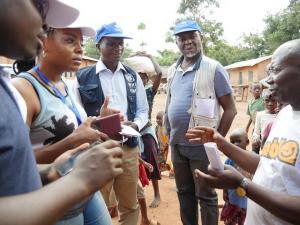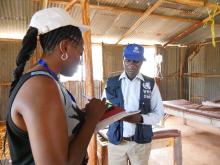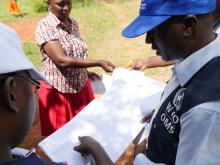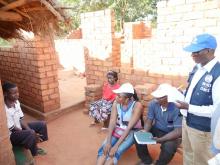Ongoing cholera outbreak in Tanzania puts local population at risk
Karago, 4 June 2015 – Tanzania’s large-scale cholera outbreak is not solely confined to the thousands of Burundian refugees who fled insecurity at home. Local Tanzanians have also been infected with the water-borne disease, prompting scaled-up surveillance efforts by the World Health Organization (WHO) and health authorities to trace and stamp out any new cases.
These intensive efforts have been rolled out over hundreds of kilometres of rugged African terrain, involving visits to remote villages to track down reports of Burundians seeking shelter with distant Tanzanian relatives.
“Before we set out in the morning, we were pretty much aware that some locals had contracted cholera,” says Dr Harry Opata, Disease Surveillance and Response focal point, WHO sub-regional office for Eastern and Southern Africa. “We were aware of a beach site in Kigoma town, and then another episode in Uvinza district.”
Dr Opata adds: “We wanted to verify the occurrences of these cases. But the most important challenge was to confirm that transmission is occurring locally, while the initial sources of transmission were the refugees or asylum seekers coming from Burundi.”
The cholera outbreak started last month, primarily among Burundian refugees entering Tanzania. More than 50 000 Burundian refugees are still being sheltered in Tanzania’s Nyarugusu refugee camp. The sudden influx of people, combined with overcrowding and poor sanitation, intensified the transmission of the ongoing cholera outbreak.
As of 2 June 2015, a total of 4578 suspected cholera cases have been reported, with fewer and fewer cases being reported on a daily basis among displaced Burundians. But worryingly, some cases are now emerging in Tanzanian communities, including more than 10 suspected cholera cases in Kigoma, the region straddling the shared border of both countries, and the main entry point for many Burundians seeking safety here.
Cholera’s entry into the local population has come as a surprise as arriving Burundians had been quickly transferred to special designated areas. Any fleeing refugee showing cholera symptoms was taken to one of the three cholera treatment centres set up to respond to the outbreak.
To better understand the dynamics of how the disease was transmitted into the local population, a WHO surveillance team, together with representatives of the Kigoma Regional Office of the Ministry of Health, visited the affected Uvinza district, a two-hour drive southwards from Kigoma town.
The WHO surveillance team reviewed data, interviewed cholera patients and gathered specifics on the outbreak with the help of the local health facilities and staff. Two clusters of around a dozen sporadic suspected cholera cases were found in isolated locations at Kibirizi Beach, Kigoma, and Uvinza District.
“In both instances we did not see an environment of well-established transmission that could further propagate and continuously affect other people,” says Dr Opata.
The team also discovered that a number of Burundians had crossed Lake Tanganyika and reached as far as Karago village. Suspected cholera cases among the local population were possibly linked to these refugees, since they came from Kigoma, one of the main hot spots of the cholera outbreak.
“We need to remain cautious, because a cholera outbreak usually starts with this pattern of only a few cases,” says Dr Opata. “After a week you may get a bloom of unwanted transmission and that could be very dangerous for small communities like here in Karago.”
“The most challenging part is to make the population understand the risks of the disease, so carrying out social mobilization and health education is key,” he adds. “We need to make sure that the villagers present themselves for treatment early enough once they have any diarrhoea or other symptoms.”
WHO is continuing to support the Ministry of Health to strengthen local health facilities along Lake Tanganyika’s shores by stocking them with enough medical supplies to treat any new cholera cases. If needed, WHO stands ready to continue supporting the deployment of additional health staff to these health facilities in the event of a possible, unmanageable caseload.
__________________________________________________
For more information, please contact:
Desloovere Pieter; Email: deslooverepi [at] who.int (deslooverepi[at]who[dot]int)
Dr Neema Kileo; Tel: +255 755 551804; Email: kileon [at] who.int (kileon[at]who[dot]int)























